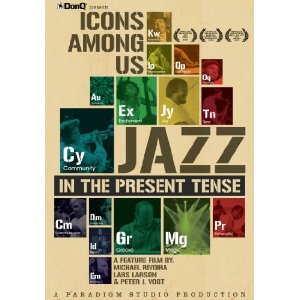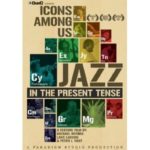
IndiePix Films and FilmBuff
“It don’t mean a thing if it ain’t got no swing” gets a new definition in the exploratory context of Icons Among Us. Originally appearing as a four-part series on the Documentary Channel, the piece, subtitled Jazz in the Present Tense comes alive through interviews with artists who have either shaped the visions of jazz in the past, or are attempting to find a fresh way to paint vibrant new colors within an old frame.
And keeping with the spirit of the times, when what was once done is questioned, and tradition, with all of its subtext and historical meanings, are coming into question, reshaped and reborn within a 21st century milieu, some of the new jazz artists are not always reverential towards what many consider to be America’s finest cultural art form. Pianists Robert Glasper and Matthew Shipp espouse the virtues of respecting those who have come before, but leaving that behind as soon as one sits down on the bench to create music. Yes, those original jazz pioneers laid the groundwork for those that play today, but what does that have to do with being in line with one’s own inner muse in 2010?
Indeed, musicians from the jamband world, with its genre which defies such a simple classification as ‘jazz’ are also probed for their thoughts on the subject. Marco Benevento delivers some insightful words on the heavy meanings and differences surrounding the terms jamband and improvisation, alongside live footage of the Benevento-Russo Duo. Also, there are revolutionary words of wisdom from iconoclastic musician Skerik, and pianist Robert Walter, who finds himself playing creative forms of expression in a new context to a jamband audience. Walter explains that no one he knows—and he “knows them all”—considers themselves a “jamband,” but that doesn’t keep them from enjoying the fact that their audiences are viewed as those types that will travel far and wide to catch a new experience at any gig where those types of musicians play. John Medeski from Medeski, Martin, and Wood, also explains his views towards jazz and improv, while the filmmakers show some fine live MMW with guitarist John Scofield work, which helps support the film’s thesis that jazz is being reassessed in modern terms.
Icons Among Us: Jazz in the Present Tense also includes musicians from a prior generation who helped expand the genre’s boundaries, like Wayne Shorter and Herbie Hancock. One can see how these two giants played music that was true to their individual personalities and talents. But one can also see how another veteran musician like Wynton Marsalis keeps the traditional spirit of jazz alive by continuing to push a more historical framework for jazz, instead of showing a way to improvise utilizing one’s own creativity. Arguably, Marsalis celebrates the past a bit too much, rather than dealing with present innovation. And, according to many musicians in the film, if you are not expressing yourself in the esoteric realms of the ethereal NOW, you ain’t got no swing after all.



No Comments comments associated with this post